This was published 8 months ago
Between the big lie and the border, hangs Arizona’s electoral prize
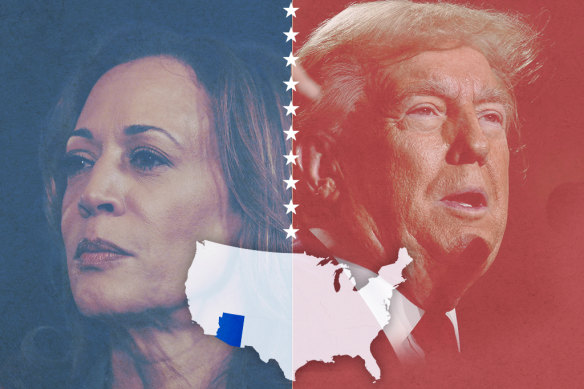
Arizona has largely been a Republican stronghold since World War II.Credit: Matthew Absalom-Wong
Phoenix, Arizona: On a bustling stretch of road in Arizona, not far from a shopping centre and a fast-food chain, a giant billboard featuring the solemn face of a grey-haired man towers over the I-17 highway between Phoenix and Sedona.
“I’m a former Trump voter. I’m a Republican. I’m voting for Harris,” the sign says.
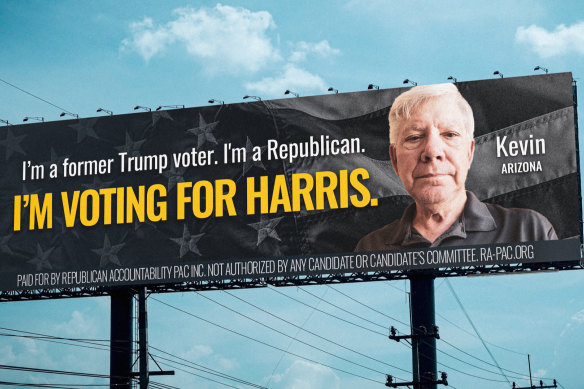
Kevin Wenker, a former pastor who voted for Trump in 2016, believed the businessman-turned-politician would grow into the role of commander-in-chief. He now proclaims his regret to the world.
The man on the billboard is Kevin Wenker, a former pastor who voted for Republican presidential candidate Donald Trump for president in 2016, believing that the flashy businessman-turned-politician would grow into the role of commander-in-chief. It didn’t take long before he regretted his decision.
“Trump spent the first three weeks of his presidency setting the tone for the next four years by arguing about how big his inauguration [crowd] size was and claiming that [former president Barack] Obama had bugged his Trump Tower offices,” Wenker says.
“It took about two or three weeks before I realised I’d made a mistake.”
Fast-forward to today and the Arizona resident isn’t about to repeat history.
Indeed, he is so determined to keep the former president out of power that he agreed to be part of a $US15 million ($22 million) billboard blitz by Republican Voters Against Trump, an advocacy group that targets right-leaning swing voters in battleground states.
“I know it won’t convince any person who is a MAGA Trump backer, but if it can reach out to the independents or the undecided and say, ‘Think before you vote’, then I’ve done my job,” he says.
It’s a viable cause for a state such as Arizona, where about 35 per cent of voters are Republicans, 30 per cent are Democrats, and the rest are registered as independents.
Home to the Grand Canyon, and with a population of 7.3 million, Arizona had been a Republican stronghold for years until President Joe Biden became the first Democrat to win it since Bill Clinton in 1996.
This was in part due to suburban voters who changed their minds about Trump after backing him in 2016, which allowed Biden to flip dozens of precincts his predecessor had won.
Still, Biden defeated Trump by only 10,457 votes here, or 0.36 percentage points, the narrowest victory in the state’s history.
This year’s election is likely to be just as much of a nail-biter, with issues such as immigration, the economy and abortion top of mind for voters in the sun-drenched state.
But while Vice President Kamala Harris and Trump were neck and neck in Arizona for most of August and September, polls suggest Harris is losing some ground.
FiveThirtyEight’s latest aggregate poll puts Trump ahead by 1 percentage point, while The New York Times aggregate has him leading by 3 points.
To that end, it’s little wonder that Harris flew to the state last week to shore up votes and confront one of her biggest political liabilities.
As the only 2024 election battleground that shares a border with Mexico, Arizona has struggled with the surge of illegal immigrants crossing into the US over the past few years, thanks in part to Biden’s decision to rescind a number of Trump-era policies.
Among them was Trump’s border wall, which Harris once described as “a vanity project” and “un-American”. Now, she’s promising to build one.
For the first time in three years, the Democrat headed to the border last week, vowing to increase criminal penalties for people who repeatedly cross illegally, give the Justice Department more resources to go after transnational gangs, and revive a bipartisan border bill that would have limited asylum rights and would boost the ranks of Border Patrol agents and immigration judges.
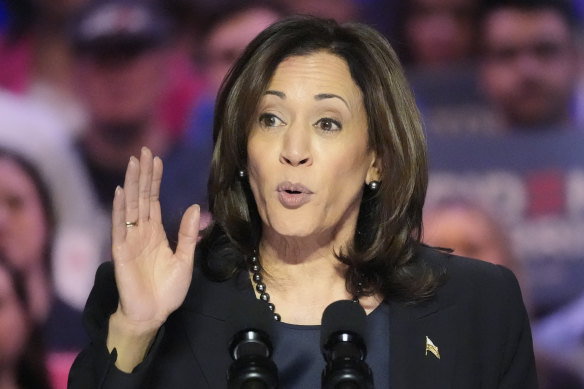
Vice President Kamala Harris has identified abortion as the issue to press in Arizona.Credit: AP
“I reject the false choice that suggests we must either choose between securing our border or creating a system of immigration that is safe, orderly and humane,” she said. “We can, and we must, do both.”
Not surprisingly, not everyone was impressed.
“Where has she been for the last 3½ years?” asked the National Border Patrol Council in a social media post. The organisation represents the agents who have been dealing with the influx of illegal immigrants.
It’s a valid question and it’s emblematic of the challenge Harris faces as the race for the White House reaches its final stretch.
In a campaign that has played out at breakneck speed after Biden withdrew his candidacy in late July, some voters ask if Harris has done enough to define herself and what she stands for.
Among them is Democrat Gilbert Romero, a former regional organiser with Healthcare Rising Arizona, which advocates for healthcare justice in the state.
Romero recalls the first time Harris ran for the Democratic presidential nomination in 2019. He was part of the progressive wing of the party coalescing around Vermont senator Bernie Sanders, which was pushing to make universal healthcare and “Medicare for all” part of the Democratic platform.
Harris, keen to bolster her progressive credentials, was supportive of the plan then, but has since reneged on the idea.
“This election is not just Kamala versus Trump; it’s Kamala versus the apathetic voter,” Romero says. “There are people who are saying, ‘All right Kamala, I’m on board, but what’s your plan?’ She needs to give us something more than what she’s given so far.”
That said, Trump also has vulnerabilities in Arizona, which is one of 10 states where abortion will also be on the ballot come election day in the form of a proposed state constitutional amendment known as Proposition 139.
If passed, the proposition will create a “fundamental right” to receive abortion care up to fetal viability (or about the 24th week of pregnancy), whereas now, the threshold is 15 weeks.
Democrats are hoping it will serve as a stark reminder that it was Trump’s Supreme Court appointees who helped pave the way for far more draconian abortion restrictions across the country.
Arizona is also ground zero for Trump’s false claim that the 2020 election was stolen – a claim also perpetuated by his allies across the state, including Senate candidate Kari Lake and US Congress members Andy Biggs and Paul Gosar.
The so-called “big lie” began on the night of the last election, when Fox News made an early call that the state was going to be won by Biden.
Such was the fury within the Trump camp that his team tried to have the decision overturned, and reportedly went so far as to call Fox owner Rupert Murdoch.
Then came the legal challenges, most of which were ultimately dismissed for lack of evidence, followed by Trump and his allies trying to pressure Arizona officials, such as then Republican governor Doug Ducey, to investigate claims of voter fraud.
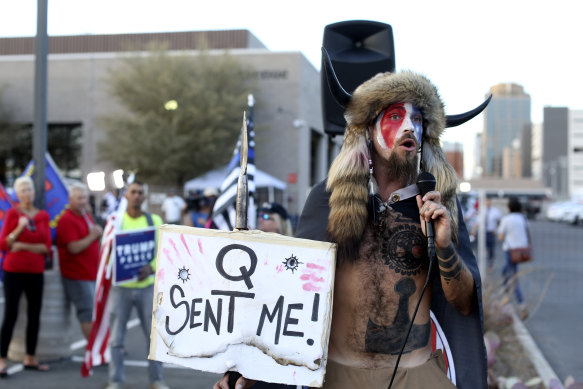
Jacob Anthony Chansley, whose face became synonymous with right-wing conspiracism, outside the Maricopa County Recorder’s Office in Arizona, in November 2020.Credit: AP
Four years later, distrust on both sides still lingers.
In a 165-page court filing lodged last week, US prosecutors made a fresh case that Trump pressured state officials and then-vice president Mike Pence to overturn his 2020 election defeat.
To safeguard this year’s election, Arizona’s Secretary of State, Adrian Fontes, has even gone so far as to co-ordinate active shooter and combat training for election workers to prepare them for “the escalating challenges of misinformation, physical threats and cybersecurity risks”.
Trump, meanwhile, continues to sow doubt, telling supporters at a rally last month to show up in force on election day and make sure that this year’s result is “too big to rig”.
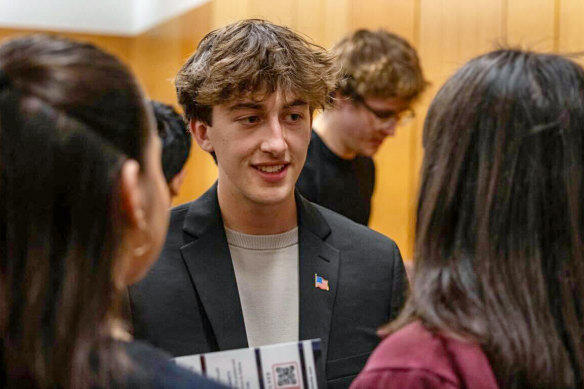
Carson Carpenter, 19, the president of the College Republicans at Arizona State University, has been working to mobilise students to get involved in the election campaign.
Carson Carpenter is determined to heed his call. As the president of the College Republicans at Arizona State University, the 19-year-old has been working for months to mobilise students to get involved in the campaign.
Some members have joined forces with Turning Point Action, the group founded by conservative warrior Charlie Kirk, to execute a ground game that centres almost entirely on reaching voters who are already primed to vote for Trump, rather than trying to convert voters. Using a custom-made mobile app, volunteers are assigned lists to chase low-propensity voters and coax them to embrace early voting, which begins in Arizona on October 9, or to cast a ballot on election day.
But if Carpenter is worried about Democrats showing up in greater numbers, you wouldn’t know it.
“I’m very confident in president Trump,” he says after class at the university’s Scottsdale campus. “Arizona has been a traditionally red state, and flipping blue in 2020 was definitely a one-off scenario.
“Harris may have had the enthusiasm, but that enthusiasm lasted about 20 days, and it’s really just started to wane.”
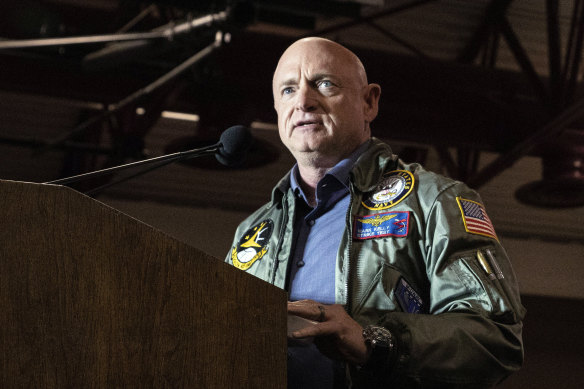
Arizona senator Mark Kelly. More voters in Arizona took part in the 2020 Senate election that elected the Democrat than in the general election.Credit: AP
Samara Klar, of the University of Arizona, disagrees. She notes that, at the 2020 election, 20,000 more voters participated in the Senate race, which elected former astronaut and centrist Democrat Mark Kelly, than in the presidential race between Trump and Biden.
In other words, she says, there were some people “who were conservative leaning and could vote for Kelly because they saw him as a non-partisan option, but they could not vote for Trump”. If the same pattern emerges this year, that could help Harris.
Whatever the case, “I’ve never, ever, ever seen a race that looks this close,” she adds. “In fact, I can’t remember the last time I saw a poll that had either of the candidates outside the margin of error. It is incredibly tight.”
Back in suburban Phoenix, Kevin Wenker agrees. And he has a theory: that there are a sizeable number of conservative voters who do not support Trump but simply aren’t declaring it publicly.
“They may not vote for Harris, but they will not vote for Trump,” he says, citing first-hand knowledge of those very people.
“They’re being quiet about it because there is a very strong minority, and a very strong MAGA group here in Arizona, which can make it difficult for you if they know that you are actively opposed to Trump.”
He should know, having been bullied out of his own congregation for daring to break ranks. And now his face is on a giant billboard in a key battleground state.
“A person should stand up for what they believe,” he says. “If you’re going to have convictions, own it.”
Get a note directly from our foreign correspondents on what’s making headlines around the world. Sign up for the weekly What in the World newsletter here.